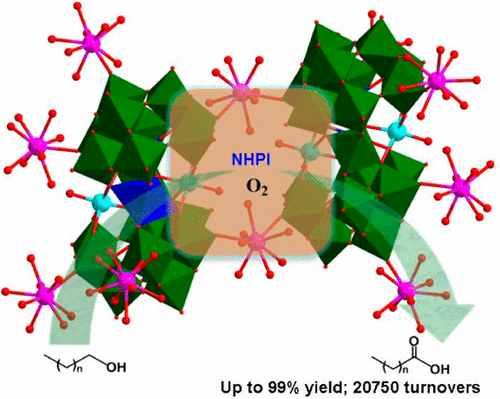当前位置:
X-MOL 学术
›
ACS Catal.
›
论文详情
Our official English website, www.x-mol.net, welcomes your feedback! (Note: you will need to create a separate account there.)
Structural Transformation of Porous Polyoxometalate Frameworks and Highly Efficient Biomimetic Aerobic Oxidation of Aliphatic Alcohols
ACS Catalysis ( IF 12.9 ) Pub Date : 2017-08-31 00:00:00 , DOI: 10.1021/acscatal.7b01985 Min Zhao 1 , Xian-Wei Zhang 1 , Chuan-De Wu 1
ACS Catalysis ( IF 12.9 ) Pub Date : 2017-08-31 00:00:00 , DOI: 10.1021/acscatal.7b01985 Min Zhao 1 , Xian-Wei Zhang 1 , Chuan-De Wu 1
Affiliation

|
Due to their inherent inert nature, it is difficult to oxidize unactivated aliphatic alcohols with molecular oxygen under mild conditions. Inspired by enzymatic catalysis, numerous biomimetic systems have been therefore established. However, low catalytic efficiency and easy auto-oxidative deactivation nature remain the problematic issues. To meet these challenges, we report herein a 2D porous polyoxometalate (POM) framework Gd4(H2O)26[WZn{Cu(H2O)}2(ZnW9O34)2]·24H2O (CZJ-11) and a 3D porous POM framework Gd4(H2O)24[WZn{Cu(H2O)}2(ZnW9O34)2]·11H2O (CZJ-12) transferred from CZJ-11 by partial dehydration, consisting of scaffolded redox-active Cu(II) sites in the sandwich-type POM cluster [WZn{Cu(H2O)}2(ZnW9O34)2]12- (abbreviated as {Zn3Cu2W19}). To mimic the catalytic mechanism of enzymes, N-hydroxyphthalimide (NHPI) and tetramethylammonium bromide (TMAB) were introduced as cocatalysts, which performed as electron donor and electron-transfer mediator, respectively. The coupled catalyst systems demonstrate analogue properties with oxygenase enzymes in the aerobic oxidation of aliphatic alcohols under mild conditions. Compared with molecular POM counterpart and metalloporphyrins, the catalytic efficiency of these POM frameworks is predominant in aerobic oxidation of unactivated aliphatic alcohols by imitating the active sites and the catalytic mechanism of enzymes. Compared with metal–organic coordination complexes, such as metalloporphyrins, the pure inorganic frameworks offer significant superiority of robustness to auto-oxidation and simple recovery for recycling with retained high catalytic efficiency.
中文翻译:

多孔多金属氧酸盐骨架的结构转化和高效仿生需氧氧化脂肪醇。
由于其固有的惰性性质,难以在温和的条件下用分子氧氧化未活化的脂肪族醇。受酶催化的启发,因此已经建立了许多仿生系统。然而,低的催化效率和容易的自氧化失活性质仍然是有问题的问题。为了应对这些挑战,我们在此报告了一种二维多孔多金属氧酸盐(POM)框架Gd 4(H 2 O)26 [WZn {Cu(H 2 O)} 2(ZnW 9 O 34)2 ]·24H 2 O(CZJ- 11)和3D多孔POM框架Gd 4(H 2 O)24 [WZn {Cu(H2 O)} 2(ZnW 9 O 34)2 ]·11H 2 O(CZJ-12)通过部分脱水从CZJ-11转移,由三明治型POM簇中的支架氧化还原活性Cu(II)位点组成[ WZn {Cu(H 2 O)} 2(ZnW 9 O 34)2 ] 12-(缩写为{Zn 3 Cu 2 W 19 })。为了模拟酶的催化机制,N引入了-羟基邻苯二甲酰亚胺(NHPI)和四甲基溴化铵(TMAB)作为助催化剂,它们分别用作电子给体和电子传递介体。偶联的催化剂体系在温和条件下脂族醇的好氧氧化中显示出具有加氧酶的类似性质。与分子POM对应物和金属卟啉相比,这些POM骨架的催化效率主要是通过模仿酶的活性位点和酶的催化机理来对未活化的脂肪醇进行有氧氧化。与金属有机配位化合物(例如金属卟啉)相比,纯无机骨架在自动氧化方面具有很强的优越性,并且在保持高催化效率的情况下,易于回收利用。
更新日期:2017-08-31
中文翻译:

多孔多金属氧酸盐骨架的结构转化和高效仿生需氧氧化脂肪醇。
由于其固有的惰性性质,难以在温和的条件下用分子氧氧化未活化的脂肪族醇。受酶催化的启发,因此已经建立了许多仿生系统。然而,低的催化效率和容易的自氧化失活性质仍然是有问题的问题。为了应对这些挑战,我们在此报告了一种二维多孔多金属氧酸盐(POM)框架Gd 4(H 2 O)26 [WZn {Cu(H 2 O)} 2(ZnW 9 O 34)2 ]·24H 2 O(CZJ- 11)和3D多孔POM框架Gd 4(H 2 O)24 [WZn {Cu(H2 O)} 2(ZnW 9 O 34)2 ]·11H 2 O(CZJ-12)通过部分脱水从CZJ-11转移,由三明治型POM簇中的支架氧化还原活性Cu(II)位点组成[ WZn {Cu(H 2 O)} 2(ZnW 9 O 34)2 ] 12-(缩写为{Zn 3 Cu 2 W 19 })。为了模拟酶的催化机制,N引入了-羟基邻苯二甲酰亚胺(NHPI)和四甲基溴化铵(TMAB)作为助催化剂,它们分别用作电子给体和电子传递介体。偶联的催化剂体系在温和条件下脂族醇的好氧氧化中显示出具有加氧酶的类似性质。与分子POM对应物和金属卟啉相比,这些POM骨架的催化效率主要是通过模仿酶的活性位点和酶的催化机理来对未活化的脂肪醇进行有氧氧化。与金属有机配位化合物(例如金属卟啉)相比,纯无机骨架在自动氧化方面具有很强的优越性,并且在保持高催化效率的情况下,易于回收利用。



























 京公网安备 11010802027423号
京公网安备 11010802027423号